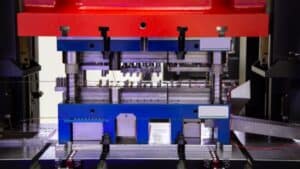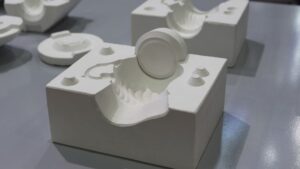What is Type 3 Anodizing?

Type 3 anodizing, often known as hard anodizing, is used to coat metal surfaces, providing them with exceptional strength and durability.
The process uses a low-temperature bath and higher current density than other methods. This results in a denser, more protective surface.
This method enhances wear resistance and extends the life of the metal. It’s especially beneficial in industries where equipment is subjected to intense usage and high levels of wear and tear.
Why Choose Type 3 Anodizing
Type 3 anodizing offers:
- High corrosion resistance
- Increased durability
- Aesthetic appeal (color options)
- Good adhesion for coatings
- Dimensional stability
- Reasonable electrical conductivity
Applications of Type 3 Anodizing Products
| Application Category | Specific Examples |
| Architecture & Construction | Exterior cladding, window frames, railings, doors, decorative elements |
| Transportation | Automotive parts, bus exteriors, some aircraft components (Type 2 often preferred for aircraft due to strength) |
| Outdoor Furniture & Fixtures | Benches, tables, planters, lighting fixtures |
| Consumer Products | Sporting goods (bicycles, camping equipment), tools, decorative items |
| Industrial Components | Machinery parts, handrails, structural supports |
| Signage & Signage Supports | Durable and visually appealing outdoor signage |
| Marine Applications | Boat parts, docks, marine structures |
| Electrical Components | Enclosures, housings for electrical equipment |
Materials and Equipment
Type 3 anodizing requires specific materials and tools to achieve high-quality results. These include suitable substrates, anodizing tanks, and specialized solutions to create a hard, durable finish.
Substrates Suitable for Type 3 Anodizing
Type 3 anodizing is most effective on aluminum alloys. Aluminum 6061 and 7075 are popular choices due to their strength and corrosion resistance.
Anodizing Equipment
1. Anodizing Tanks:
- Material: Typically made of non-corrosive materials such as plastic, fiberglass, or stainless steel.
- Function: Holds the anodizing solution where the aluminum parts are immersed during the anodizing process.
2 . Power Supply:
- Type: DC (direct current) power supply.
- Function: Provides the necessary electrical current to create the anodizing reaction on the aluminum surface.
3. Heating System:
- Type: Electric heaters or immersion heaters.
- Function: Maintains the temperature of the anodizing solution within the desired range for optimal results
4. Cooling System:
- Type: Chillers or cooling coils.
- Function: Regulates the temperature of the anodizing solution, especially in large-scale operations.
5. Rinsing Tanks:
- Function: Used to rinse the aluminum parts before and after anodizing to remove contaminants and residual chemicals.
Types of Anodizing Equipment:
- Batch Anodizing Equipment: Used for processing multiple parts at once, suitable for smaller operations.
- Continuous Anodizing Equipment: Designed for high-volume production, allowing for continuous processing of aluminum parts.
- Automated Anodizing Systems: Incorporate robotics and automation for precision, consistency, and efficiency in large-scale operations.
Process and Mechanisms

Type 3 anodizing involves a series of steps to prepare the surface, anodize the material, and seal.
Pre-Anodizing Surface Preparation
The first step in type 3 anodizing is surface preparation. The surface must be cleaned thoroughly to remove any dirt, grease, or oxidation. This may involve degreasing, acid cleaning, and etching.
Deoxidizing is another process where a chemical bath removes oxides and other impurities. Proper cleaning ensures even anodizing and prevents defects. This preparation also creates micro-textures, which enhance the effectiveness and quality of the anodizing.
Anodizing Process Steps
Next is the anodizing itself. The process uses an electrolytic solution, typically sulfuric acid, and a direct current power supply. These conditions create a thick oxide layer on the surface of the aluminum. The parts get submerged in the electrolyte, and current flows through the metal, forming a barrier.
Post-Anodizing Sealing Techniques
Sealing is the final step to enhance the corrosion resistance of the anodized layer. There are several methods available, including hot water sealing, nickel acetate sealing, or cold sealing.
Hot water sealing uses high temperatures to hydrate the oxide layer, closing pores. Nickel acetate introduces chemical sealing, providing extra protection. Cold sealing offers efficiency at lower temperatures, typically involving fluoride-based solutions.
What Should Be Considered During the Process?
When performing Type 3 anodizing, four critical factors to consider are the anodizing solution, current density, temperature, and treatment duration.
The composition and concentration of the anodizing solution are essential to achieve the desired thickness, color, and uniformity of the anodized layer.
Additionally, the current density applied during anodizing directly affects the thickness and uniformity of the oxide layer. Incorrect current density can lead to uneven or porous coatings.
Maintaining a stable and controlled temperature during the anodizing process is crucial for consistent results, as temperature fluctuations affect the anodizing reaction and the final product quality.
Furthermore, the duration of the anodizing process directly impacts the thickness of the oxide layer: a treatment time that is too short may not provide adequate protection, while excessive duration can lead to overly thick layers or other issues.
Limitations of Type 3 Anodizing

Type 3 anodizing works best on specific aluminum alloys. Not all metals or aluminum grades are suitable, which might limit choices depending on the desired properties.
The color options for type 3 anodizing are limited, typically resulting in darker shades such as black, gray, or bronze. This is due to the thicker oxide layer formed during the process.
Furthermore, the process can add thickness to the part, which might not be suitable for precision components, so tight tolerances are vital.
Maintenance and Care
Keeping type 3 anodized surfaces in good condition ensures they last long and stay effective. Regular cleaning helps. Use mild soap and water for routine cleaning. Avoid harsh chemicals or abrasive materials. These can damage the finish.
If deeper cleaning is needed, a soft cloth or sponge works well. Stubborn stains may need a gentle touch with a soft-bristled brush. Be sure not to scratch the surface.
Storing type 3 anodized items properly also helps in care. If possible, store them in a dry, clean environment.
Lubrication can be necessary for moving parts. A light oil can help keep parts functioning smoothly. Make sure to use the oil recommended for anodized surfaces.
Try to avoid exposing anodized surfaces to extreme temperatures for long periods. It can cause the surface to weaken over time.
Frequently Asked Questions
What are the main differences between type ii anodize and type iii anodize?
The main difference between Type ii and Type iii anodizing lies in the thickness and structure of the anodized layer, which directly impacts the resulting properties.
What is the typical thickness range for Type iii anodizing?
Type 3 anodizing typically creates a coating thickness between 1.8 to 6.6 mils. This thickness depends on the application and desired durability.
How does Type iii anodizing differ from Type ii regarding durability and application?
Type iii anodizing, also known as hard anodizing, is more durable than Type ii. It is used in applications where high wear resistance is needed, such as in aerospace and military settings.
What are the factors that affect the cost of Type 3 anodizing services?
Cost factors include the size and complexity of the part, desired thickness, and any specific processing requirements. Additionally, the color finish can also impact the price.






